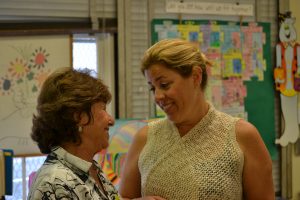UPDATE: My book, Capturing the Spark: Inspired Teaching, Thriving Schools is on sale now!
This blog post originally appeared in Capturing the Spark at EdWeek Teacher (10/29/16).
For the first time in nearly twenty years of public school teaching, I have a teaching partner, a history teacher with whom I share two classes made up of entirely the same 10th grade students. I’m the English teacher in this team, and our classes are in their first year of a three-year, social justice themed pathway in our high school. Not since I taught in a private school this kind of overlap, allowing me to share with a colleague my observations and questions about so many shared students, and to hear his observations as well. It can be quite helpful to have validation for changes I’m seeing in class, or to gain insights about what works or doesn’t work in our efforts to help each student improve.

Sharon Schneider Barrish and Nikki Kanan discuss a lesson at Brentwood Science Magnet Elementary School.
It’s a form of collaboration that I wish we had more time for in secondary schools. The number of teacher-student contacts in middle school and high school can be a blessing or a curse. For a student in a self-contained elementary school classroom, that one teacher works with the student all day and across academic disciplines. With that depth and breadth of information, the teacher is in a great position to communicate and address the student’s needs. At the secondary level, where teachers might see 100, 150, even 200 students, the depth of understanding is not uniformly strong, as we spend less time with each student and see that student in a more limited range of activities and circumstances.
How can we turn our numbers into a strength? We should recognize that each student and teacher relationship is unique. We have all known certain teachers in our own childhood, and certain students in our teaching experience, with whom we’ve “clicked” – or not – for any number of reasons. When there’s a student I’m having trouble supporting, sometimes another teacher understands the student in a way that I don’t, and can help me by providing another lens or a different approach. When I have a strong relationship with a student, I might be able to help a colleague appreciate something important about the student, adding a missing piece to a puzzle.
When I worked in private schools, these types of conversations were normal occurrences, because every teacher at a given grade level shared every student (obviously, very small schools). In large comprehensive public schools, it takes more of an effort. Our school’s guidance department has organized occasional lunches that bring teachers together to share concerns about students at a particular grade level each week. These lunches can be effective, though not every teacher is able to attend, and the focus is on students in need. Certainly we need to prioritize students at risk, but I still want to improve my work with every student. Regardless of their grades, I have an interest in reaching better understanding and building stronger relationships.
The size of a school matters if we’re engaging in these kinds of efforts. Some larger comprehensive public schools create smaller programs or groups, calling them houses, academies, pathways, or using some other term. They’re often organized around a certain theme or interest, but have the added benefit of creating more shared connections among students and staff. Even then, however, the opportunity to build a shared understanding around support for individual students may be accomplished by chance or by design. I invite readers to share how their secondary schools facilitate this kind of communication, if at all. Let’s hear about what works, or what you’d propose doing to enhance the effort.
